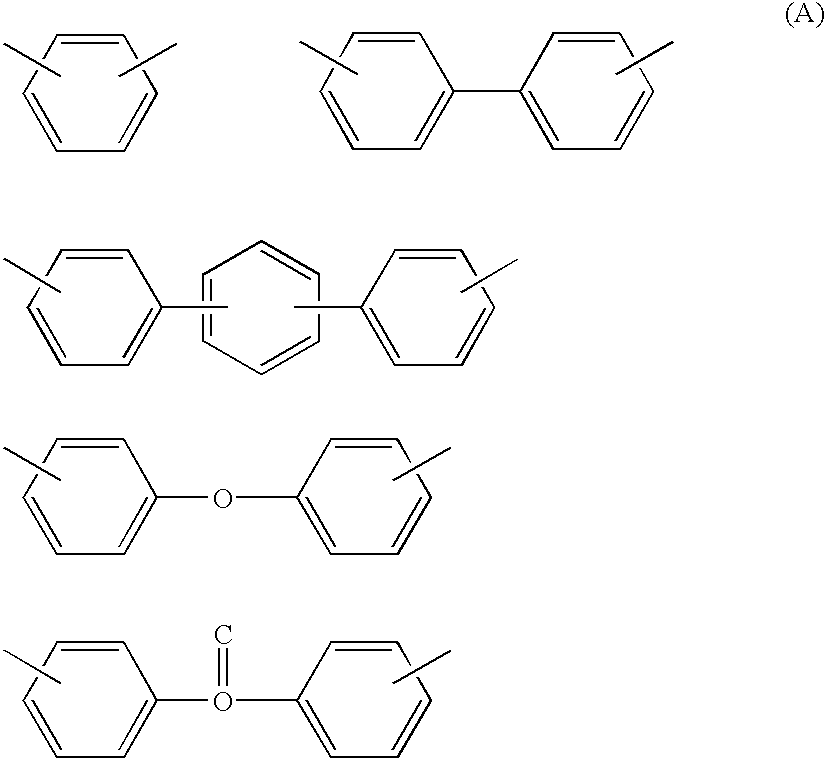Heat-resistant polyether, curable polyether, and coating liquid for forming a polyether film
- Summary
- Abstract
- Description
- Claims
- Application Information
AI Technical Summary
Benefits of technology
Problems solved by technology
Method used
Image
Examples
example 1
[0049]A four neck flask of 500 ml was charged with 34 g (0.08 mol) of 1,1-bis(4-hydroxy-3-phenylphenyl)cyclohexylidene, 6.4 g of caustic soda, 110 g of benzophenone and 60 g of toluene to allow reflux dehydration to proceed. After completion of dehydration, 25 g (0.08 mol) of dibromobiphenyl was added into the flask. Further, a mixed liquid of cuprous chloride-pyridine was added into the flask as a catalyst, and the mixture in the flask was allowed to react at an internal temperature of from 170 to 190° C. for 8 hours. After having been cooled to room temperature, the reaction liquid was diluted with tetrahydrofuran, and the diluted liquid was added to a large quantity of a mixed liquid of methanol-acetic acid to precipitate a reaction product. The precipitated crystal was filtered, washed with a large quantity of methanol and then dried under reduced pressure, to give a polyether. The polystyrene-converted weight-average molecular weight of this polyether determined by GPC (with HL...
example 2
[0050]A four neck flask of 500 ml was charged with 30 g (0.080 mol) of 1,1-bis(4-hydroxy-3-phenylphenyl)isopropylidene, 6.4 g of caustic soda, 110 g of benzophenone and 60 g of toluene to allow reflux dehydration to proceed. After completion of dehydration, 25 g (0.08 mol) of dibromobiphenyl was added into the flask. Further, a mixed liquid of cuprous chloride-pyridine was added into the flask as a catalyst, and the mixture in the flask was allowed to react at an internal temperature of from 170 to 190° C. for 6 hours. After having been cooled to room temperature, the reaction liquid was diluted with tetrahydrofuran, and the diluted liquid was added to a large quantity of a mixed liquid of methanol-acetic acid to precipitate a reaction product. The precipitated crystal was filtered, washed with a large quantity of methanol and then dried under reduced pressure, to give a polyether. The polystyrene-converted weight-average molecular weight of this polyether was 4600. The polyether th...
example 3
[0051]A four neck flask of 500 ml was charged with 28 g (0.080 mol) of bis(4-hydroxyphenyl)diphenylmethane, 6.4 g of caustic soda, 110 g of benzophenone and 60 g of toluene to allow reflux dehydration to proceed. After completion of dehydration, 25 g (0.080 mol) of dibromobiphenyl was added into the flask. Further, a mixed liquid of cuprous chloride-pyridine was added into the flask as a catalyst, and the mixture in the flask was allowed to react at an internal temperature of from 170 to 190° C. for 20 hours. After having been cooled to room temperature, the reaction liquid was diluted with tetrahydrofuran, and the diluted liquid was added to a large quantity of a mixed liquid of methanol-acetic acid to precipitate a reaction product. The precipitated crystal was filtered, washed with a large quantity of methanol and then dried under reduced pressure, to give a polyether. The polystyrene-converted weight-average molecular weight of this polyether was 3700. The polyether thus obtaine...
PUM
| Property | Measurement | Unit |
|---|---|---|
| Temperature | aaaaa | aaaaa |
| Structure | aaaaa | aaaaa |
| Electrical resistance | aaaaa | aaaaa |
Abstract
Description
Claims
Application Information
 Login to View More
Login to View More - R&D
- Intellectual Property
- Life Sciences
- Materials
- Tech Scout
- Unparalleled Data Quality
- Higher Quality Content
- 60% Fewer Hallucinations
Browse by: Latest US Patents, China's latest patents, Technical Efficacy Thesaurus, Application Domain, Technology Topic, Popular Technical Reports.
© 2025 PatSnap. All rights reserved.Legal|Privacy policy|Modern Slavery Act Transparency Statement|Sitemap|About US| Contact US: help@patsnap.com



